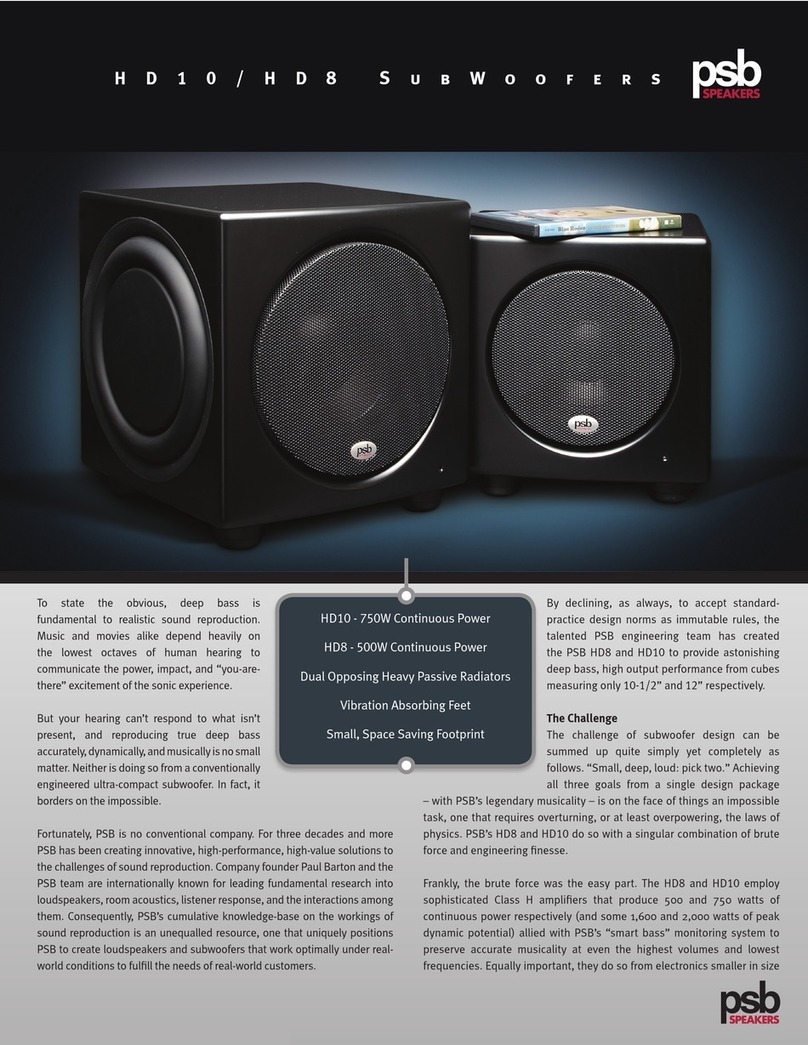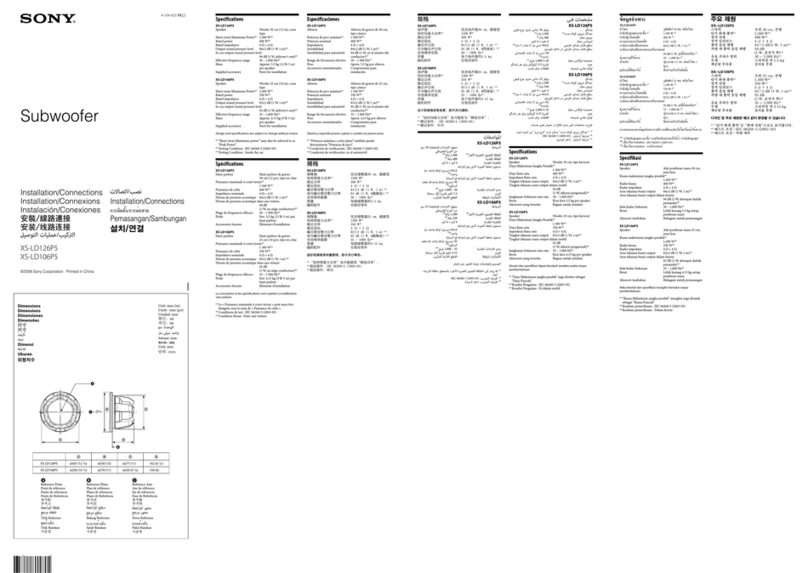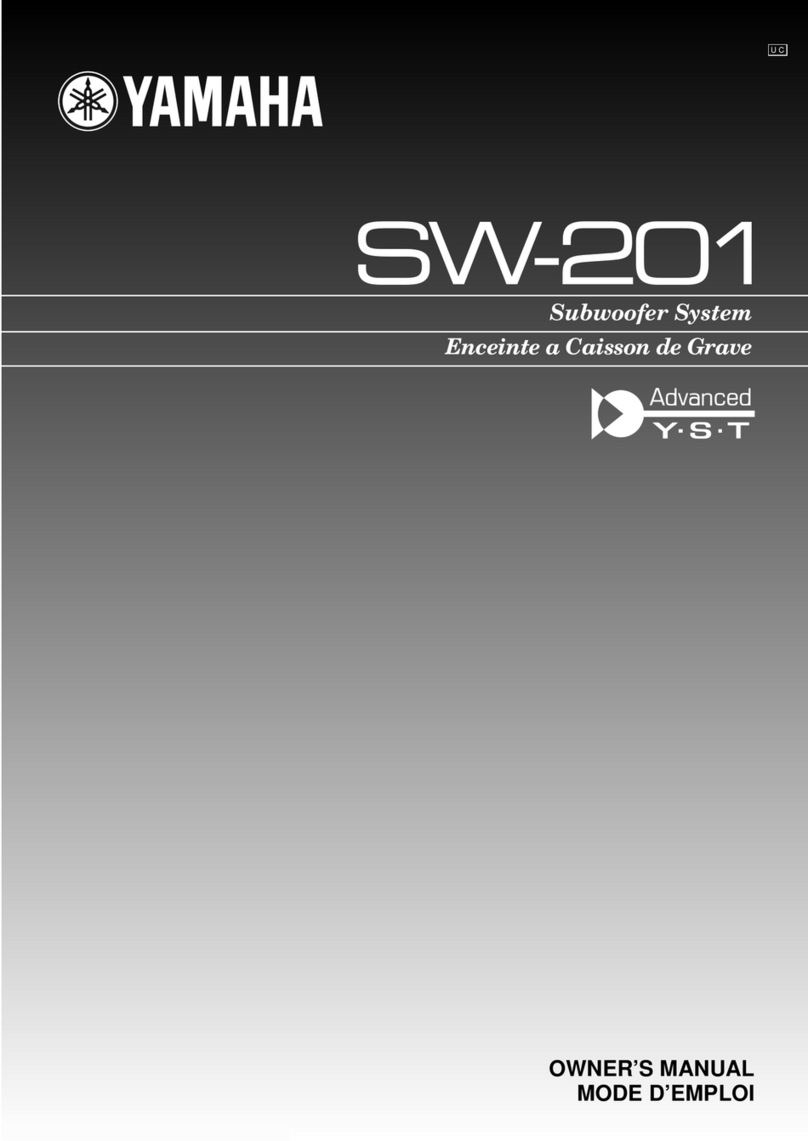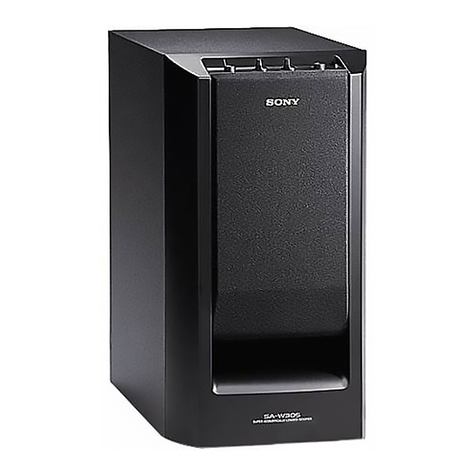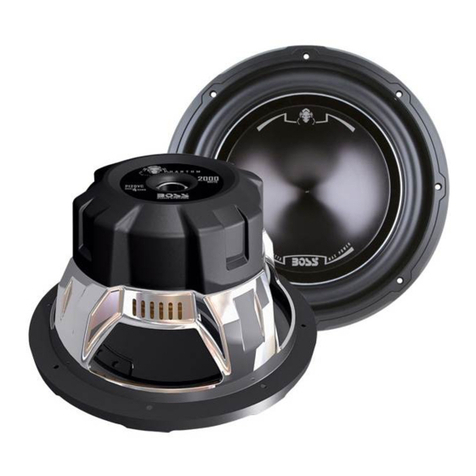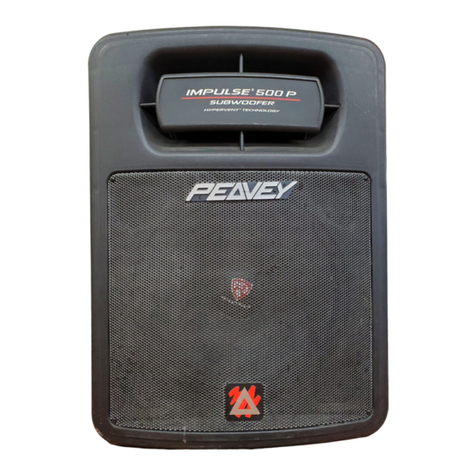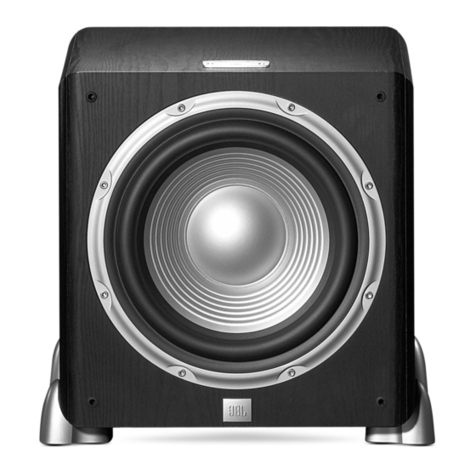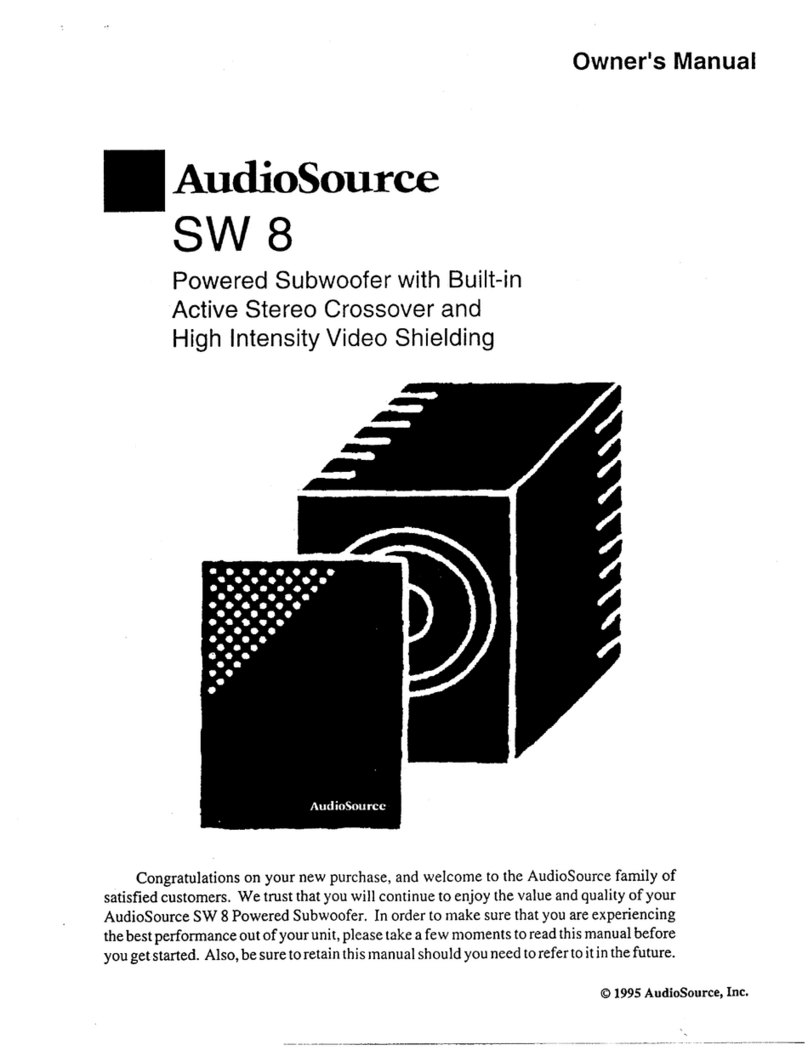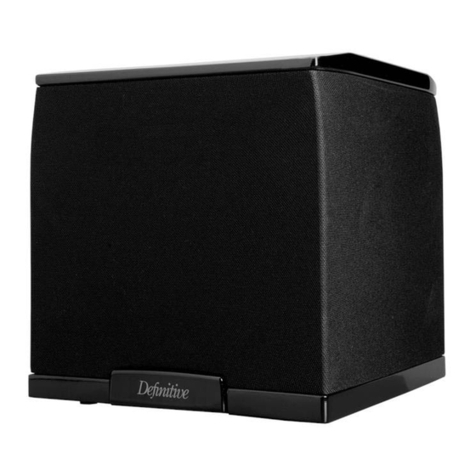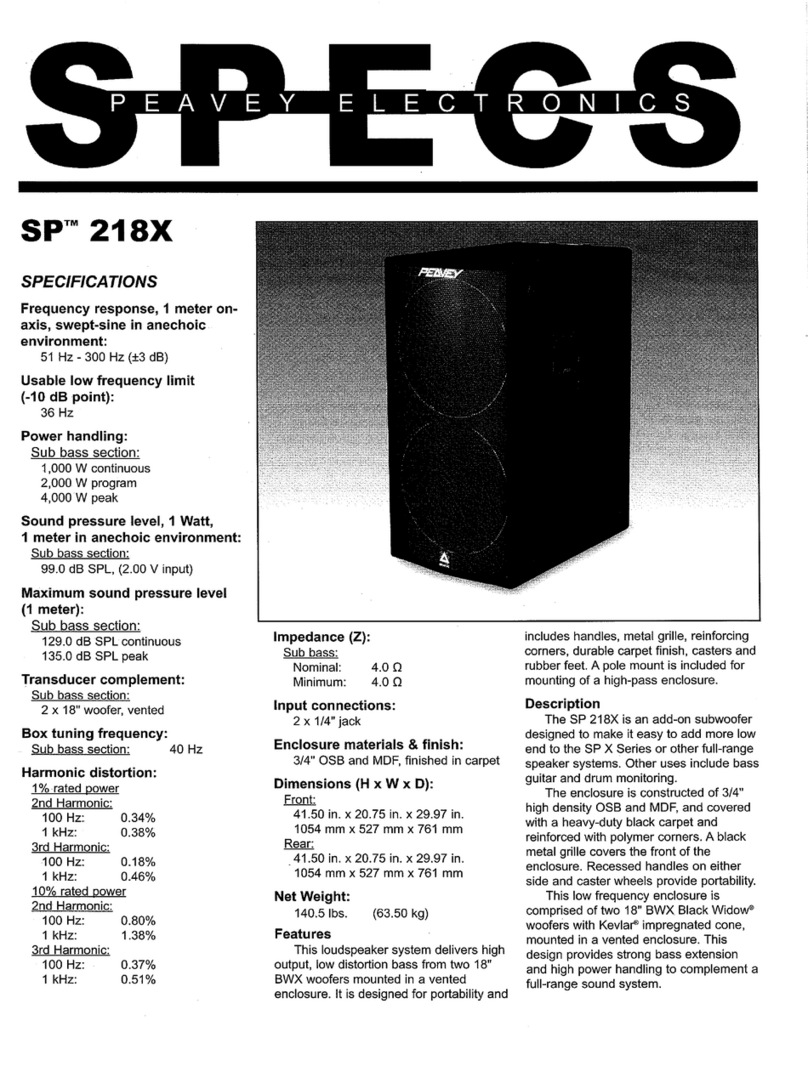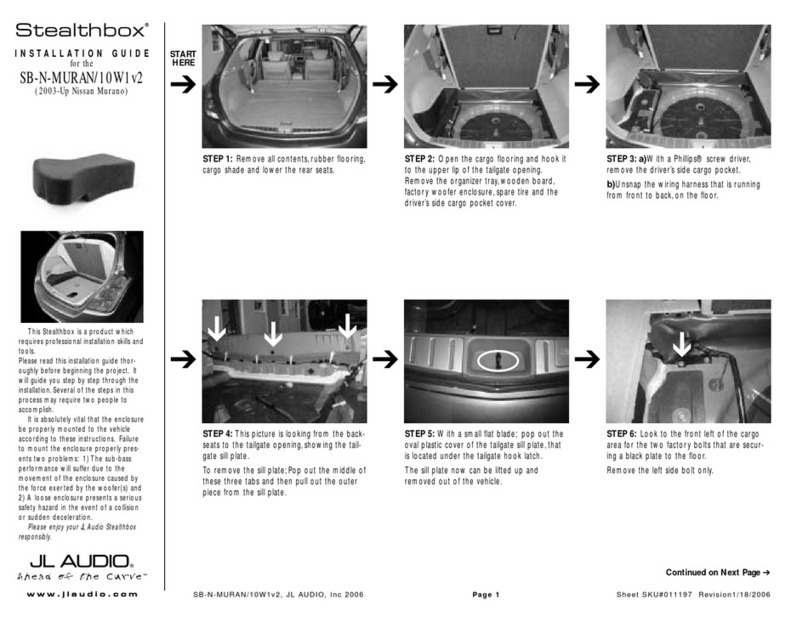PSB Powered Subwoofers User manual

PSB
Powered
Subwoofers
Caissons
de
grave
extremes
Su :oofers
activos
Aktiv-
ubwoofer
OWN
'S
GUIDE
!i>
"'In[)
···D'UTILISATION
GUiA
DEL
PROPIETARI
BENUTZERANLEITU
www.psbspeakers.com


CONTENTS
I.
Important Safety Instructions 4
II.
Introduction 5
Ill. Quickstart 6
IV.
Features, Controls, AC Power 6
V.
Room Acoustics, Subwoofer Placement, Multiple 8
Subwoofers &Control Settings
VI. Connecting the Subwoofer to Your Audio System
11
A.
LFE Connection
B.
Low/Line Level
C.
High/Speaker Level
D.
High/Speaker Level Output
E.
Using Multiple Subwoofers
VII. Set-Up Calibration
13
VIII. Troubleshooting
14
Figure 1
16
Figure 2 17
Figure 3
18
Figure 4 19
Figure 5
20
3

I.
IMPORTANT
SAFETY
INSTRUCTIONS
1.
2.
3.
4.
5.
6.
7.
8.
9.
Read these instructions.
Keep these instructions.
Heed all warnings.
Follow all instructions.
Do not use this apparatus near water.
Clean only with dry cloth.
Do not block any ventilation openings. Install in accordance with the manufacturer's
instructions.
Do
not
install near
any
heat sources such as radiators, heat registers, stoves,
or
other
apparatus (including amplifiers) that produce heat.
Do not defeat the safety purpose
of
the polarized
or
grounding-type plug. A polarized
plug has two blades with one wider than the other. A grounding type plug has two
blades and a third grounding prong. The wide blade
or
the third prong are provided
for your safety. Ifthe provided plug does not fit into your outlet, consult an electrician
for replacement
of
the obsolete outlet.
10. Protect the power cord from being walked on
or
pinched particularly at plugs, conve-
nience receptacles, and the point where they exit from the apparatus.
11.
Only use attachments/accessories specified by the manufacturer.
12. Use only with the cart, stand, tripod, bracket,
or
table specified by the
manufacturer,
or
sold with the apparatus. When a cart is used, use cau-
tion when moving the cart/apparatus combination to avoid injury from
tip-over.
13. Unplug this apparatus during lightning storms
or
when unused for long periods
of
time.
14. Refer all servicing to qualified service personnel. Servicing is required when the ap-
paratus has been damaged
in
any way, such as power-supply cord
or
plug is damaged,
liquid has been spilled
or
objects have fallen into the apparatus, the apparatus has been
15. exposed to rain or moisture, does not operate normally,
or
has been dropped.
The apparatus shall not be exposed to dripping
or
splashing and that no objects filled
with liquids, such as vases, shall be placed on the apparatus.
16. WARNING:
To
reduce the risk
of
fire
or
electric shock, this apparatus should not be
exposed to rain
or
moisture.
17. The mains plug
or
an appliance coupler is used as the disconnect device, the discon-
nect device shall remain readily operable.
The
lightning
flash
with
arrowhead
symbol
within
an
equilateral
triangle,
is
intended
to
alert
you
to
the
presence
of
uninsulated
"dangerous
voltage"
within
the
product's
enclosure
that
may
be
of
sufficient
magnitude
to
constitute
a
risk
of
electric
shock
to
persons.
The
exclamation
point
within
an
equilateral
triangle
is
intended
to
alert
you
to
the
presence
of
important
operating
and
maintenance
(servicing)
instructions
in
the
literature
accompanying
the
product.
Notice
of
FCC
Compliance
Warning: Changes
or
modifications to this unit not expressly approved by the party respon-
sible for compliance could void the user's authority to operate the equipment.
NOTE: This equipment has been tested and found to comply with the limits for a Class B
digital device, pursuant to Part 15
of
the FCC Rules. These limits are designed to provide
reasonable protection against harmful interference in a residential installation. This equip
4

ment generates, uses, and can radiate radio frequency energy and, if not installed and
used
in
accordance with the instructions, may cause harmful interference to radio com-
munications. However, there is no guarantee that interference will not occur
in
a particular
installation. If this equipment does cause harmful interference to radio or television recep-
tion, which can be determined by turning the equipment off and on, the user
is
encouraged
to try to correct the interference by one or more
of
the following measures:
Reorient or relocate the receiving antenna.
Increase the separation between the equipment and receiver.
Connect the equipment into
an
outlet on a circuit different from that to which the
receiver
is
connected.
Consult the dealer or
an
experienced radio TV technician for help.
Notes
on
environmental
protection
At the end
of
its useful life, this product must not
be
disposed of with
regular household waste but must
be
returned to a collection point for
the recycling of electrical and electronic equipment. The symbol on the
product, user's manual and packaging, point this out.
The materials can
be
reused
in
accordance with their markings. Through
re-use, recycling of raw materials, or other forms of recycling of old
products, you are making an important contribution to the protection
of
our environment.
Your local administrative office can advise you of the responsible waste
disposal point.
II.
INTRODUCTION
PSB
subwoofers
are
designed
to
provide
the
flattest
possible
frequency
response,
full
bass
extension,
low
distortion
and
high
output.
Beyond
these
characteristics
there
are
a
few
other
parameters
that
we
feel
are
very
important
in
the
design
of
a
subwoofer.
First
and
foremost,
a
PSB
subwoofer
must
be
musical.
A
subwoofer
should
also
have
the
abil-
ity
to
play
musically
even
when
overloaded
or
stressed.
For
this
reason
PSB
subwoofers
incorporate
proprietary
limiting
circuitry
preventing
audible
overload
while
remaining
true
to
the
dynamics
of
the
music.
This
circuitry
combines
peak
limiting
circuits
that
hold
amplifier
signal
swing
to
the
point
just
short
of
the
amplifier's
clipping,
with
compression
circuitry
that
will
reduce
the
amplifier's
gain.
Managing
heat
dissipation
is
challenging
with
today's
greater
power
demands.
Where
suitable,
PSB
subwoofers
use
the
latest
implementation
of
super
efficient
Class
D
power
amplification,
featuring
an
automatically
varying
switching
frequency
that
maintains
maximum
efficiency
and
low
THO
under
all
conditions.
PSB
woofers
are
always
designed
to
reduce
mechanical
noise
and
prevent
harsh
sounds
at
the
excursion
extremes.
Ports
have
large
radius
end
flares
to
reduce
noise
from
air
tur-
bulence.
Cabinets
and
amplifiers
are
designed
to
prevent
air
leaks,
which
can
contribute
minute
amounts
of
noise.
All
of
our
designs
are
exhaustively
tested
to
survive
15
continu-
ous
hours
of
being
driven
to
maximum
output.
Whichever
PSB
subwoofer
you
have
chosen,
we
hope
that
you
appreciate
the
attention
5

to
detail
that
has
gone
into
its
design.
Please
take
the
time
to
read
the
following
sections
about
the
placement
of
your
subwoofer,
its
connections
and
adjustments.
Enjoy
your
PSB
subwoofer.
Ill.
QUICKSTART
If
you
cannot
wait
to
hear
your
new
PSB
subwoofer,
then:
Turn
off
all
other
components
and
follow
one
of
the
connection
diagrams.
Connect
the
supplied
power
cord
to
the
AC
power
socket.
Set
the
PSB
subwoofer
volume
control
to
its
minimum
position
(counterclockwise),
and
then
plug
the
subwoofer
into
an
active
AC
outlet.
Use
the
same
receptacle
as
the
rest
of
your
audio/video
system
or
another
on
the
same
electrical
circuit
in
order
to
avoid
ground
hum.
Set
the
subwoofer's
Sub
Cut-Off
Frequency
control
to
its
midpoint
and
set
the
phase
switch
or
control
to
oo.
Flip
the
Power
Switch
to
the
on
position.
Play
bass-rich
material,
and
slowly
bring
up
the
Sub
Volume
control
(clockwise)
until
the
subwoofer
contributes
a
natural
level
of
low
frequency
sound.
Now
please
read
the
rest
of
this
guide
and
fine-tune
your
installation
accordingly-it
will
be
time
well
spent!
IV.
FEATURES,
CONTROLS,
AC
POWER
VOLUME
~
00
0
0 0
0 0
00
010
0 0
sot)o
100
0 0
0 0
500
0150
CROSSOVER
0
VOLUME
CONTROL
Adjusts
the
output
level
of
the
PSB
subwoofer
only:
This
is
not
intended
as
a
day-to-day
volume
control.
See
"VII
Setup
Calibra-
tion".
CROSSOVER
FREQUENCY
CONTROL
Adjusts
the
upper
limit
of
the
subwoofer's
frequency
range.
Continuously
variable
from
50Hz
to
150Hz
for
precise
matching
of
subwoofer
bass
reproduction
with
the
main
(left
and
right)
stereo
speakers.
See
"VII
Setup
Calibration".
ON/STANDBY
INDICATOR
LIGHT
The
light
is
located
on
the
front
of
the
subwoofer.
With
both
the
120
and
230
volt
versions,
the
subwoofer
is
initially
in
stand-by
mode
awaiting
the
presence
of
an
audio
signal.
This
status
is
indicated
by
a
red
light.
When
the
subwoofer
receives
an
audio
signal
the
indicator
light
colour
will
change
to
green.
With
no
audio
signal,
the
subwoofer
will
stay
on
for
approximately
15
minutes.
6

8
°00
0 0
0 0
0 0 0
360
+
Left
-
@@
@(@)
+
Right
-
HIGH LEVEL INPUT FROM RECEIVER
+
Left
-
+
Right
-
HIGH LEVEL OUTPUT
TO
SPEAKERS
PHASE
SWITCH
OR
CONTROL
Selects
the
subwoofer
output
phase
between
in-phase
(0°)
and
out-of-phase
(180°),
or
up
to
360°
to
compensate
for
the
low
to
mid
bass
acoustic
effects
of
different
placement
locations
and
listening
rooms.
See
"VII
Setup
Calibration"
HIGH/SPEAKER
LEVEL
INPUT
TERMINALS
For
connecting
the
PSB
subwoofer
to
receivers
or
integrated
am-
plifiers
equipped
with
speaker
outputs
only.
See
"
VI
Connecting
The
Subwoofer
to
Your
Audio
System."
HIGH/SPEAKER
LEVEL
OUTPUT
TERMINALS
For
connecting
the
PSB
subwoofer
to
speakers.
See
"
VI
Connect-
ing
The
Subwoofer
to
Your
Audio
System."
~~~~TL;:~~~
LOW/LINE
LEVEL
INPUT
JACKS
PREAMP
Left
Right
LOW LEVEL
OUTPUT
TO
AMP
Left
Right
LFE INPUT
LFE OUTPUT
For
connecting
the
PSB
subwoofer
to
a
separate
component
pre-
amplifier,
or
to
an
integrated
amplifier
or
receiver
with
preamplifier-
out/main-in
connections,
at
line
level.
See
"
VI
Connecting
The
Subwoofer
to
Your
Audio
System."
LOW/LINE
LEVEL
OUTPUT
JACKS
For
connecting
the
PSB
subwoofer
to
a
separate
component
pre-
amplifier,
or
to
an
integrated
amplifier
or
receiver
with
preamplifier-
out/main-in
connections,
at
line
level.
See
"
VI
Connecting
The
Subwoofer
to
Your
Audio
System."
LFE
JACKS
For
connecting
the
PSB
subwoofer
to
a
separate
component
preamplifier,
or
to
an
integrated
amplifier
or
receiver
with
LFE/Sub-
woofer
output
connections.
See
"
VI
Connecting
The
Subwoofer
to
Your
Audio
System."
7

AC POWER SOCKET
POWER
8
OFF
AC POWER SOCKET
AC
POWER
SOCKET
Supplies
AC
power
to
the
PSB
subwoofer.
Connect
the
supplied
power
cord
to
the
AC
power
socket.
Plug
the
power
cord
into
any
standard
wall
outlet.
The
same
receptacle
as
the
rest
of
the
system
or
another
on
the
same
electrical
circuit
should
be
used
to
avoid
ground
hum.
The
PSB
subwoofer
has
its
own
self-contained
amplifier
and
thus
requires
AC
power
(keep
this
in
mind
when
selecting
a
location).
You
may
plug
the
power
cord
into
any
standard
wall
outlet
and
leave
the
connection
in
the
wall
as
the
PSB
subwoofer
draws
extremely
little
current
when
idle.
If
you
are
away
for
an
extended
period
you
may
want
to
turn
off
the
power
switch
or
unplug
your
PSB
subwoofer.
POWER
SWITCH
The
Power
Switch
turns
off
the
subwoofer's
internal
amplifier.
EXTERNAL
FUSE
When
you
turn
on
the
subwoofer
and
there
is
no
LED
light
and/or
sound,
please
check
the
fuse
(accessible
from
the
rear
panel)
to
ensure
it
is
electrically
intact.
A
spare
fuse
is
contained
within
the
fuse
holder
compartment
behind
the
inscribed
text.
Use
a
wide
slot
screwdriver
to
pry
the
fuse
holder
compartment
from
the
AC
power
socket.
If
it
is
necessary
to
replace
the
fuse,
use
a
fuse
equivalent
to
the
type
and
rating
of
the
fuse
shipped
with
the
product.
See
the
specifications
page
at
the
end
of
the
manual
for
a
detail
description
of
the
fuse
required
for
your
model
of
subwoofer.
V.
ROOM
ACOUSTICS,
SUBWOOFER
PLACEMENT,
MULTIPLE
SUBWOOFERS
&
CONTROL
SETTINGS
A.
Room
Acoustics
If
you
are
critical
about
low-frequency
response,
there's
quite
a
bit
of
useful
experi-
mentation
you
can
do,
especially
in
combination
with
the
crossover,
level,
and
phase
controls
of
our
subwoofers.
Begin
by
considering
the
size
of
the
listening
room.
The
larger
the
volume
of
air
a
speaker
must
move,
the
more
acoustic
output
is
required
to
achieve
the
sound
levels
8

you
want.
In
smaller
rooms,
sound
attenuation
tends
to
be
offset
by
reinforcement
from
wall
reflections.
In
larger
spaces,
sound
has
to
travel
to
reach
the
reflecting
sur-
faces
and
then
to
your
ears,
which
means
it
has
to
be
louder
to
begin
with.
With
tra-
ditional
full-range
speakers,
that
involves
properly
matching
amplifier
power,
speaker
sensitivity,
impedance
and
power
handling.
Most
of
the
power
goes
to
reproducing
bass,
so
using
powered
subwoofers
and
separate
midrange/treble
satellites
allows
for
a
conservative
draw
on
power
from
your
main
amplifier,
while
ensuring
a
good
match
between
the
low-frequency
amplifier
and
the
woofer.
After
size,
the
most
important
aspect
of
a
listening
room
is
its
shape.
In
any
room,
sound
reflects
off
the
walls,
ceiling,
and
floor.
If
the
distance
between
two
opposite
parallel
surfaces
is
a
simple
fraction
of
the
wavelength
of
a
particular
frequency,
notes
of
that
frequency
will
bounce
back
and
forth
in
perfect
phase-an
effect
called
a
standing
wave
or
room
mode.
At
some
point
in
the
room,
this
note
will
be
reinforced
substantially;
at
others
it
will
cancel
out
almost
entirely.
If
the
prime
listening
seat
is
placed
at
either
of
these
locations,
the
note
will
be
a
horrible
boom
or
virtually
non-
existent.
Almost
all
rooms
are
susceptible
to
some
standing
waves
at
low
frequen-
cies,
but
careful
positioning
of
the
speakers
and
the
listening
seat
can
minimize
the
effects.
The
only
way
to
find
out
what
works
best
is
by
experimentation.
Speaker
positioning
may
be
fairly
limited
in
your
room
to
still
get
proper
imaging,
and
some
of
these
positions
may
still
result
in
standing
waves.
Use
of
a
subwoofer
or
two
makes
this
more
controllable.
Positioning
of
the
bass
speakers
has
almost
no
impact
on
imaging,
so
a
subwoofer
can
be
positioned
with
only
standing
waves
in
mind.
B.
Subwoofer
Placement
The
loudest
bass
output
from
a
subwoofer
comes
from
corner
placement.
The
outward
flaring
of
walls
from
a
corner
focuses
low
frequencies,
giving
them
no
place
to
go
but
toward
the
listener.
In
the
case
of
subwooofers,
there
is
no
penalty
in
overall
balance
for
this
maximal
bass,
since
your
main
speakers
can
be
located
elsewhere.
In
most
cases,
there
should
be
plenty
of
bass
from
corner
placement.
If
you
are
seated
in
a
null
spot
where
sound
from
the
subwoofer
is
cancelled
or
diminished
by
out-of-phase
reflections,
you
will
have
to
move
either
the
subwoofer
or
your
listening
position
until
you
get
the
desired
bass.
Flipping
the
phase
control
180
degrees
sometimes
may
make
a
difference,
especially
if
the
null
is
a
product
of
cancellations
caused
by
interaction
with
low
frequencies
from
your
main
speakers.
If
the
opposite
is
happening,
where
direct
and
reflected
bass
waves
converge
in
phase
and
produce
too
strong
a
peak
at
your
listening
position,
you
can
change
position
or
change
your
sub's
level
control
(or
possibly
the
crossover
frequency
chosen).
The
best
method
for
positioning
a
subwoofer
is
to
put
the
subwoofer
in
your
listening
chair,
then
play
music
with
lots
of
bass
through
the
system
(something
with
steady
low
frequencies
or
continuous
test
tones).
Move
around
the
room
and
note
where
9

the
bass
sounds
best;
if
you
place
the
subwoofer
in
that
location,
you
should
get
the
same
bass
performance.
This
test
only
works
if
you
have
your
ears
at
the
same
height
as
where
the
subwoofer
will
be,
so
you
may
have
to
get
down
low.
A
recom-
mended
starting
point
for
the
placement
of
this
subwoofer
would
be
in
either
of
the
front
corners
of
the
room,
on
either
side
of
the
main
speakers.
Most
bass
output;
least
even
bass
response
I
~
I
Moderate
bass
output;
more
even
bass
response
/
Subwoofer
I~
I
Lowest
bass
output;
most
even
bass
response
C.
Multiple
Subwoofers-Why
Two
Subs
Are
Better
Than
One
Sometimes
the
listening
room
is
not
conducive
to
achieving
satisfying
amounts
or
quality
of
bass.
There
are
rooms
with
troublesome
dimensions,
especially
those
that
are
more
cubical.
In
such
a
case,
two
subwoofers
placed
carefully
to
work
with
each
other
are
recommended
to
handle
acoustical
anomalies.
This
can
also
be
applied
when
the
problem
is
too
much,
or
too
uneven,
bass.
The
overall
system
benefits
from
each
subwoofer
correcting
the
acoustic
problems
caused
by
the
other.
The
two
subwoofers
do
not
have
to
be
identical.
A
very
good
starting
point
for
positioning
two
subwoofers
is
to
place
one
each
on
the
centre
of
opposing
walls.
Experimenting
with
positioning
as
previously
described
should
be
used
for
determining
the
location
of
the
second
subwoofer,
except
in
this
instance
one
is
listening
for
the
minimum
amount
of
bass
output.
D.
Control
Settings
Once
a
reasonably
smooth
response
has
been
achieved
by
careful
positioning
of
the
subwoofers,
the
overall
performance
can
be
fine-tuned
by
means
of
the
speaker
con-
trols.
The
low-pass
filter
controls
the
upper
limit
of
the
subwoofer's
frequency
range.
This
should
be
set
high
enough
to
overlap
the
low
frequency
cutoff
of
the
satellite
speakers,
but
not
high
enough
to
localize
specific
sounds
from
the
subwoofer.
If
the
frequency
response
of
your
satellite
speakers
is
such
that
the
subwoofer's
low-
pass
filter
must
be
set
higher
than
about
80Hz
in
order
to
avoid
gaps
in
the
overall
system
response,
then
you
might
be
able
to
localize
specific
sounds
from
the
sub-
woofer.
These
sounds
may
seem
to
come
from
beside
or
behind
you.
One
solution
is
10

to
ensure
the
subwoofer
is
in
the
front
of
the
listening
area;
another
is
to
use
multiple
subwoofers
to
diffuse
such
sounds.
Subwoofers
also
offer
a
phase
control
so
the
upper
frequencies
produced
will
not
cancel
out
the
lower
frequencies
of
the
satellites.
Adjustment
of
this
control
can
have
great
effect
on
spectral
smoothness
in
the
crossover
area.
Phase
changes
with
frequency,
however,
so
these
controls
may
need
readjusting
every
time
you
vary
the
cutoff
frequency.
The
overall
level
of
the
subwoofer's
output
may
also
be
adjusted.
To
gain
smooth
response,
be
careful
not
to
set
this
too
high.
VI.
CONNECTING
THE
SUBWOOFER
TO
YOUR
AUDIO
SYSTEM
There
are
several
ways
to
connect
a
subwoofer
into
a
system.
For
best
results
overall,
we
recommend
using
LFE
or
Low/Line
Level
connections.
When
making
a
stereo
Low/Line
Level
connection,
be
sure
to
follow
the
coding
on
the
cables
to
maintain
left-to-left
and
right-to-right.
Use
high
quality,
well-shielded,
low
capacitance
RCA
cables
of
minimal
necessary
length,
to
avoid
picking
up
noise
in
the
cable
runs.
When
making
a
High/Speaker
Level
connection,
in
addition
to
maintaining
left-to-left
and
right-to-right,
be
sure
to
use
the
coding
of
the
pair
of
wires
in
each
speaker
cable
to
maintain
phase-+/red/rib/writing
to
+/red/rib/writing
and
-/white/smooth/clear
to
-/white/smooth/clear.
We
recommend
minimum
16
gauge
wire
and,
for
longer
runs,
larger
(lower
gauge)
wire.
In
multi-subwoofer
systems
subwoofer
inputs
can
be
paralleled.
A.
LFE
Connection
Connecting
Home
Theatre
Equipment
(see
Figure
1,
page
16):
You
can
use
a
single
RCA
cable
to
connect
the
LFE/Subwoofer
Output
of
your
receiver,
integrated
amplifier,
or
preamplifier
to
the
LFE
Input
on
the
subwoofer.
Home
Theatre
receivers,
integrated
amplifiers,
surround
sound
processors,
and
preamplifiers
usually
have
a
special
Subwoofer
Output
to
provide
the
optional
Dolby
Digital
or
DTS
Low
Frequency
Effects
(LFE)
Channel
present
on
many
movie
and
other
programming
sources.
To
reproduce
these
deep-bass
effects
(when
they
are
present),
supplementing
the
bass
information
in
the
main
channels,
this
output
must
be
connected
to
the
subwoofer.
The
LFE
or
Subwoofer
Output
is
filtered
by
most
receivers/processors.
The
subwoofer's
variable
low
pass
filter
is
usually
not
required
and
will
not
affect
the
frequency
response
of
the
subwoofer
when
using
the
LFE
Input.
In
2-channel
source
material
there
is
no
information
in
the
LFE
channel.
Howe_ver,
11

bass
signal
can
be
diverted
to
the
subwoofer
by
selecting
the
appropriate
AV
receiver/processor
surround
mode.
B.
Low/Line
Level
Connecting
Stereo
Equipment
Using
Low/Line
Level
(See
Figure
2
&
3,
page
17
-18)
If
your
receiver
or
integrated
amplifier
has
preamplifier
outputs,
or
if
you
are
using
a
separate
preamplifier,
the
preferred
connection
is
from
the
Preamplifier
Output
of
the
electronics
to
the
Low
Level
Input
of
the
subwoofer.
Use
a
dual
RCA
audio
cable.
Additionally,
you
may
need
to
use
Y-connectors
at
the
Preamplifier
Output
to
also
send
signals
to
the
Power
Amplifier/Main
Input.
Connecting
the
Low/Line
Level
Outputs
from
the
subwoofer
back
to
the
Power
Amplifier
Inputs
is
an
important
option
(see
Figure
3,
page
18).
The
Low/Line
Level
Inputs
of
the
subwoofer
are
internally
processed
through
an
active
high
pass
filter
(at
12d8/octave
below
80Hz)
to
the
Low/Line
Level
Outputs
of
the
subwoofer.
Connect-
ing
the
Low/Line
Level
Outputs
from
the
subwoofer
back
to
the
Power
Amplifier
In-
puts
delivers
the
processed
signal,
with
reduced
low
frequency
content,
to
the
main
speakers.
With
less
low
frequency
demands,
the
main
speakers
can
play
louder.
Particularly
with
smaller
and/or
less
efficient
main
speakers,
relieving
speakers
other
than
the
subwoofer
of
the
demands
of
reproducing
low
frequencies
will
allow
greater
sound
output
and
dynamic
capabilities
from
the
other
speakers
and
from
the
system
overall.
C.
High/Speaker
Level
Connecting
Stereo
Equipment
with
High/Speaker
Level
(See
Figure
4
&
5,
page
19-20):
You
also
can
get
excellent
sonic
results
by
connecting
the
High/Speaker
Level
Output
of
your
receiver,
integrated
amplifier
or
power
amplifier
to
the
High
Level
Input
of
the
subwoofer.
Use
standard
speaker
cable
and
maintain
polarity
+
-,
as
well
as
right
and
left
channel.
Speaker
wires
can
be
run
onwards
from
the
subwoofer
directly
to
the
main
speak-
ers.
This
replaces
running
wires
from
the
receiver
or
amplifier
to
the
main
speakers.
Twist
the
ends
of
each
input
wire
from
the
electronics
together
with
the
correspond-
ing
wire
to
the
speakers
and
insert
them
both
into
each
corresponding
input
binding
post
of
the
subwoofer.
Be
sure
to
avoid
all
contact
between
wires
into
the
separate
binding
posts.
D.
High/Speaker
Level
Output
Using
High/Speaker
Level
Output
(see
Figure
4,
page
19)
allows
speaker
wires
to
be
run
onwards
easily
from
the
subwoofer
directly
to
the
main
speakers.
This
re-
places
running
wires
from
the
receiver
or
amplifier
to
the
main
speakers.
The
signals
from
the
subwoofer
to
the
main
speakers
are
looped
through,
full-range.
12

E.
Using
Multiple
Subwoofers
Particularly
in
difficult
rooms
with
difficult
layouts,
using
two
subwoofers
is
an
alternative
to
smooth,
as
well
as
to
increase
bass
response.
One
subwoofer
can
be
located
to
increase
response,
with
the
second
subwoofer
located
to
smooth
re-
sponse.
The
two
subs
do
not
need
to
be
identical.
Please
refer
to
Section
V,
Multiple
Subwoofers
for
further
information.
VII.
SET-UP
CALIBRATION
The
following
procedure
assumes
your
PSB
subwoofer
is
installed
and
connect-
ed.
If
possible,
work
in
a
team
with
another
person:
one
listening,
one
making
subwoofer-control
adjustments.
1.
Set
Sub
Volume
to
0,
Sub
Cut-Off
Frequency
to
50Hz.
Set
any
loudness,
bass
and
treble,
and/or
equalizer
controls
on
your
preamplifier
or
integrated
amplifier
or
receiver,
or
other
components,
to
their
nominal
(midpoint
or
off)
positions.
2.
Play
a
familiar
compact
disc,
video
soundtrack
or
other
source
that
includes
substantial
deep-bass
content
over
an
extended
section.
Your
PSB
dealer
can
help
you
select
a
few
such
titles.
3.
Gradually
turn
the
Sub
Volume
control
clockwise
until
you
achieve
natural
balance
between
the
subwoofers
deep-bass
output
and
your
main
left
and
right
loudspeakers.
4.
Slowly
turn
the
Sub
Cut-Off
Frequency
control
clockwise
to
reach
the
best
mid-bass
blend
with
your
main
left
and
right
speakers.
This
will
be
the
point
at
which
the
upper
bass
retains
solid
impact
and
fullness.
Boom
or
muddi-
ness
is
the
result
if
the
control
is
too
high.
A
thin,
"reedy"
quality
to
the
mid-
bass
such
as
deep
male
voices
(FM
announcers;
Darth
Vader)
is
the
result
if
the
control
is
too
low.
5.
Adjust
the
Phase
control
between
oo
and
180°
or
360°
several
times,
leav-
ing
it
in
the
position
that
yields
the
fullest
low
to
mid
bass
output.
You
will
now
probably
want
to
repeat
steps
3&
4
to
double-check
the
subwoofer
blend.
Cycling
through
steps
3&
4
several
times
with
slightly
different
settings
of
both
the
Sub
Volume
and
Sub
Cut-Off
Frequency
controls
will
help
you
get
the
most
musical
performance
from
your
PSB
Subwoofer
and
your
system.
The
best
com-
bination
is
that
which
yields
the
most
solid
very-low-bass
sounds,
without
mid-
bass
boom
or
a
gap
in
response
between
the
subwoofer
and
the
main
speakers.
The
Sub
Cut-Off
Frequency
and
Sub
Volume
controls
are
interactive.
Raising
the
latter
while
lowering
the
former
can
have
the
effect
of
extending
deep-bass
13

.
response
somewhat,
with
a
small
sacrifice
in
overall
loudness
capability
(this
will
still
be
well
beyond
the
full-range
loudness
capability
of
most
systems).
In
gen-
eral,
for
well-recorded
acoustic
music
the
lowest
Sub
Cut-Off
Frequency
setting
that
yields
a
smooth
transition
between
subwoofer
and
main
speakers
is
often
the
best
choice,
and
will
promote
deeper
low-bass
extension.
Note:
The
Sub
Volume
control
is
not
a
bass-boost
or
volume
control.
It
is
a
set-
and-forget
adjustment,
not
intended
for
day-to-day
adjustment.
Use
your
pream-
plifier
or
receiver/integrated
amp
tone
controls
to
modify
program
tonal
balance.
VIII.
TROUBLESHOOTING
Symptom
No
sound
On/standby
indicator
not
lit
No
sound
On/standby
indicator
remains
red
Action
Ensure
the
main
power
switch
is
on.
This
switch
is
located
at
the
back
of
the
subwoofer.
Ensure
the
power
cord
is
connected
to
the
subwoofer
and
plugged
into
a
live
AC
outlet.
Check
the
main
fuse
located
in
the
power
cord
socket
and
replace
as
required.
If
the
new
fuse
also
blows,
the
subwoofer
amplifier
requires
service.
All
PSB
subwoofers
utilize
signal
sensing
auto
on/off
circuitry.
If
no
signal
is
sent
to
the
subwoofer,
it
will
not
power
up
and
the
front
panel
on/standby
indicator
will
remain
red.
When
using
the
subwoofer
output
of
a
receiver
or
processor,
no
signal
may
be
immediately
present
in
this
output.
The
subwoofer
will
only
power
up
when
bass
signal
appears
at
the
subwoofer
input.
If
the
low
level
cable
or
speaker
cable
connection
is
poor
or
has
been
severed,
the
subwoofer
will
not
power
up.
Swap
cables
to
determine
if
this
is
the
source
of
the
problem.
To
ensure
the
problem
is
not
associated
with
the
subwoofer,
rapidly
disconnect
and
connect
the
subwoofer
low
level
or
high
level
input.
If
the
subwoofer
on/standby
indicator
then
illumi-
nates
green,
the
receiver/processor/amp
may
not
be
sending
a
signal
to
the
subwoofer.
When
driving
the
low
level
inputs
from
a
subwoofer
output,
ensure
the
receiver/processor
is
correctly
configured
to
provide
signal
at
the
subwoofer
output.
Further,
a
red
on/standby
indicator
can
be
caused
by
an
over-
voltage
or
undervoltage
condition
at
the
AC
outlet.
14

Symptom
Sounds
distorted
Hum
Action
The
indicator
will
also
turn
red
during
abnormal
operating
condi-
tions
such
as
excessive
internal
temperature
or
a
presence
of
DC
voltage
at
the
amplifier
output,
in
which
case
the
subwoofer
needs
to
be
serviced.
Lower
volume
if
the
subwoofer
begins
to
sound
distoned
to
determine
if
playback
at
a
lower
level
solves
the
problem.
If
a
slight
reduction
in
level
solves
the
problem,
then
the
subwoofer
level
was
too
high.
If
the
distorted
sound
remains
at
a
low
level,
driver(s)
may
be
damaged.
Hum
that
appears
when
using
the
subwoofer's
low
level
input(s)
is
usually
caused
by
using
an
inferior,
damaged,
exceptionally
long
low
level
cable
or
cables
routed
near
high
current
wiring/
appliances.
Replace/shorten
the
low
level
cable
connecting
the
subwoofer
to
the
source
equipment
(receiver
or
processor).
Low
level
cable
runs
of
longer
than
20
feet
may
require
the
use
of
a
line
driver
(not
available
from
PSB).
Hum
heard
when
using
the
subwoofer's
high
level
input(s)
is
usually
caused
by
an
intermittent
or
missing
positive
or
negative
connection.
Ensure
there
is
a
good
connection
between
all
speaker
wires
connecting
the
subwoofer
and
receiver/amplifier.
If
the
subwoofer
high
level
connection
is
routed
through
a
switch
box,
ensure
the
box
shorts
the
positive
and
negative
connec-
tions
together
when
the
subwoofer
should
be
inactive.
Hum
will
result
if
the
switch
box
floats
the
positive
or
negative
connection.
Decreasing
the
volume
control
of
the
subwoofer
and
increasing
the
volume
control
of
the
receiver/processor/amplifier
subwoofer
output
can
sometimes
reduce
hum
to
an
acceptable
level.
See
your
dealer
if
you
require
service.
Authorized
PSB
dealers
are
equipped
to
handle
almost
all
problems.
You
may
locate
your
nearest
PSB
authorized
dealer
on-line
at
www.psbspeakers.com.
If
the
problem
is
not
resolved,
please
contact
us,
providing
the
model
name,
serial
number,
date
of
purchase,
dealer
name,
and
a
full
description
of
the
problem.
We
appreciate
your
purchase,
and
hope
this
owner's
guide
helps
you
enjoy
the
excep-
tional
performance
that
PSB
speaker
systems
have
to
offer.
We
wish
you
many
years
of
enjoyable
listening!
15

Figure
1
WITH LFE INPUT
INTEGRATON AVEC ENTREE
INTEGRACION CON ENTRADA LFE
MIT LFE-EINGANG
I'
"
""
I'
LFE
IIIPUT
LFE
Ill
PUT
..
--- E)
~
I
~
To
LFE INPUT
of
second
~
subwoofer (optional)
&----------- •
~
Wf4
........
...
0
~
Vers !'ENTREE LFE du
~
deuxieme caisson de
PUT
basse (en option)
LFE
OUTPUT
Subwoofer
LFE
OUT
./
'
SPKR/
A
SPKR/L
+ -+ -
[gJ[gJ
( )
(gl(gl
SUB/LFE OUT
AN
RECEIVER, INTEGRATED AMPLIFIER, PRE-
AMPLIFIER OR PROCESSOR
RECEPTEUR
AN,
AMPLIFICATEUR INTEGRE,
PREAMPLIFICATEUR OU AUTRE APPAREIL
RECEPTOR
AV,
AMPLIFICADOR INTEGRADO,
PREAMPLIFICADOR 0 PROCESADOR
AN-RECEIVER, INTEGRIERTER VERSTARKER,
VORVERSTARKER ODER PROZESSOR
A LFE INPUT (entrada
LFE) del segundo sub-
woofer (opcional)
Zum LFE-EINGANG des
zweiten Subwoofers
(optional)
2nd Subwoofer
Use
this
configuration
to
connect
the
subwoofer
to
an
AN
receiver
or
processor's
subwoofer/
LFE
output
provided
your
AN
receiver/processor
subwoofer/LFE
output
is
low
pass
filtered.
Utilisez cette
configuration
pour
raccorder
le
caisson
de basse aun
recepteur
AN
ou
a
Ia
sortie
caisson
de basse/LFE
d'un
appareil a
condition
que
Ia
sortie
caisson
de basse/LFE
du
recepteur
AN/de
l'appareil
soit
dotee
d'un
filtre
passe-bas.
Use esta
configuraci6n
para
conectar
el
subwoofer
a
un
receptor
AV o a
Ia
salida de
subwoofer/
LFE del procesador,
siempre
que esas
salidas
esten procesadas
por
un
filtro
pasabajos.
Verwenden Sie diese
Konfiguration,
um
den
Subwoofer
an den
Subwoofer/LFE-Ausgang
eines
AN-Receivers
oder
Prozessors anzuschlieBen,
unter
der
Voraussetzung,
dass
der
AN-Receiver/
Prozessor-Subwoofer/LFE-Ausgang
tiefpassgefiltert
ist.
16

Figure 2
WITH
LOW
LEVEL INPUT
AVEC L'OPTION D'ENTREE BAS-NIVEAU
CON OPCION de ENTRADA a NIVEL
BAJO
To
2nd Subwoofer
(optional)
Vers le deuxieme caisson
de basse (en option)
MIT LOW-LEVEL-EINGANG
* Y connector not required for
single subwoofer operation
* Connecteur
en
Y non requis
pour !'utilisation d'un seul cais-
son de basse
*
No
se
requiere
un
conector
en
Y para trabajar con
un
solo
subwoofer
*
Y-Steckverbinder nicht er-
forderlich
fUr
den Betrieb eines
einzelnen Subwoofers
A un segundo subwoofer
r -- - - - - -
..
(opcional)
J
t
LOW
LEVEL
INPUT
FROM
PREAMP
Subwoofer
..._
Zum
2.
Subwoofer
,.
-
-.,..
, (optional)
This method
of
wiring does not limit low
frequencies reaching left and right main
speakers.
...-----.
....
_____
...,._-_-
.....
------~
I
Ce
cab/age ne limite pas les basses
frequences atteignant les haut-parleurs
principaux gauche
et
droite.
PREAMPLIFIER
I
I
I
I
Esta conexi6n no limita las frecuancias
bajas que /Iegan
a
los altavoces princi-
pales derecho e izquierdo.
SPKRIR
+ -
rglrgl
RL
INPUT
I
MAIN -
IN
SPKR I L
+ -
rglrgl
POWER
I
AMPLIFIER
I
I
L-----------------------~
Diese Verkabelungsmethode schrankt
die niedrigen Frequenzen fur den linken
und rechten Hauptlautsprecher nicht
ein.
ALTERNATE: RECEIVER
OR
INTEGRATED AMPLIFIER WITH PRE-AMP
OUT
AND
MAIN-IN
JACKS
POSSIBILITE :
RECEPTEUR
OU AMPLIFICATEUR INTEGRE AVEC PRE-
AMPLIFICATEUR
ET
PRISES D'ENTREE PRINCIPALES
ALTERNATIVA:
RECEPTOR
0 AMPLIFICADOR INTEGRADO CON SALIDA
DE
PREAMPLIFICADOR
(PRE-AMP OUT) Y
ENTRADAALAMPLIFICADOR
PRINCIPAL (MAIN-IN)
ALTERNATIV:
RECEIVER
ODER
INTEGRIERTER
VERSTARKER
MIT
VORVERSTARKER-AUSGANGS-
UND HAUPT-EINGANGSBUCHSEN
Low
level
connections
wire
the
subwoofer
to
a
preamplifier
or
to
the
"pre-out"
jacks
ofan
inte-
grated
amplifier
or
receiver,
using
standard
RCA cables.
Les
raccordements
bas-niveau
relient
le
haut-parleur
d'extreme
grave
a
un
preamplificateur
ou
aux
bornes
«sortie
preamplificateur»
d'un
preamplificateur,
d'un
amplificateur
integre
ou
d'un
recepteur
au
moyen
de
cables RCA
standard.
Para
conexi6n
al
nivel
bajo
se
conecta
el
subgrave
al
pre-amplificador
o a
los
conectores
"pre
salida"
de
un
amplificador
integrado
o
receptor
usando
cables
comunes
tipo
RCA.
Low-Levei-AnschiUsse
verdrahten
den
Subwoofer
mit
einem
Vorverstarker
oder
den
Vorverstar-
kerausgangsbuchsen
eines
integrierten
Verstarkers
oder
Receivers
mittels
standardmaBigem
RCA-Kabel.
17

Figure 3
WITH
LOW
LEVEL
INPUT
&
OUTPUT
AVEC L'OPTION
D'ENTREE
BAS-NIVEAU
et
de SORTIE BAS-NIVEAU
CON OPCION de
ENTRADA
y
SALIDA
a NIVEL BAJO
MIT LOW-LEVEL-EINGANG
UND-AUSGANG
To
2nd Subwoofer
(optional)
*
Y connector not required for
single subwoofer operation
*
Connecteur
en
Y non requis
pour !'utilisation d'un seul cais-
son de basse
*
No
se
requiere
un
conector
en
Y para trabajar con un solo
subwoofer
* Y-Steckverbinder nicht er-
forderlich
fUr
den Betrieb eines
einzelnen Subwoofers
This method
of
wiring limits low fre-
quencies reaching left
and
right main
speakers.
Ce
cab/age limite les basses frequenc-
es atteignant les haut-parleurs princi-
paux gauche et droite.
Esta conexi6n limita las frecuancias
bajas que /Iegan
a
los altavoces princi-
pales derecho e izquierdo.
Diese Verkabelungsmethode schrankt
die niedrigen Frequenzen
fOr
die linken
und rechten Haupt/autsprecher ein.
Vers le deuxieme caisson
de basse (en option)
LEft
,
; Zum
2.
Subwoofer
(optional)
LOW
LEVEL
LOW
LEVEL
OUTPUT
INPUT
FROM
TO
AMP
PREAMP
Subwoofer
SPKR/R
+ -
[g)
[g)
INPUT
I
MAIN -
IN
SPKR/
L
+ -
[gl[2J
ALTERNATE: RECEIVER OR INTEGRATED AMPLI-
FIER WITH PRE-AMP OUTAND MAIN-IN JACKS
POSSIBILITE : RECEPTEUR OU AMPLIFICATEUR
INTEGRE AVEC pgEAMPLIFICATEUR ET PRISES
D'ENTREE PRINCIPALES
ALTERNATIVA: RECEPTOR 0 AMPLIFICADOR
INTEGRADO CON SALIDADE PREAMPLIFICADOR
(PRE-AMP OUT) Y
ENTRADAALAMPLIFICADOR
PRINCIPAL (MAIN-IN)
ALTERNATIV: RECEIVER ODER INTEGRIERTER
VERSTARKER MIT VORVERSTARKER-AUSGANGS-
UND HAUPT-EINGANGSBUCHSEN
18
PREAMPLIFIER
POWER
AMPLIFIER

Figure 4
WITH HIGH LEVEL
INPUT
&
OUTPUT
AVEC
ENTREE
et
SORTIE
HAUT-NIVEAU
CON
ENTRADA
y
SALIDA
de NIVEL
BAJO
MIT
HIGH-LEVEL-EINGANG
UNO
-AUSGANG
+
+ - + -
SPKR
I
R SPKR
I
L
RECEIVER, INTEGRATED AMPLIFIER OR POWER
AMPLIFIER
RECEPTEUR, AMPLIFICATEUR INTEGRE OU AM-
PLIFICATEUR DE PUISSANCE
RECEPTOR, AMPLIFICADOR INTEGRADO 0 AMPLIFI-
CADOR
DE
POTENCIA
RECEIVER, INTEGRIERTER VERSTARKER ODER
ENDVERSTARKER
To
2nd Subwoofer (optional)
Vers le deuxieme caisson de
r - - - -
+
basse (en option}
,..
_ _+
A un segundo subwoofer
I
(opcional}
I
Zum
2.
Subwoofer (optional}
.&
A
+
+
Ritht
Left
Subwoofer
LEFT
+
RIGHT
SPEAKER SPEAKER
l:iiiiiiiiiiiiiiiiiiiiiiiiiiiiiiiiiiiiiiiii~
High
level
connections
wire
the
subwoofer
to
the
speaker
output
terminals
of
a
receiver
or
ampli-
fier,
just
as
if
the
subwoofer
was
a
pair
of
speakers.
Les
connexions
haut-niveau
relient
le
haut-parleur
d'extreme
grave
aux
bornes
de
sorties
h.-p.
d'un
recepteur
ou
d'un
amplificateur,
comme
s'il
s'agissait
d'une
paire
d'enceintes
acoustiques.
Para
conexi6n
al
nivel
alto
se
conecta
el
subgrave
a
las
terminales
de
salida
para
altavoz
de
un
receptor
o
amplificador
como
si
se
tratase
de
un
par
de
altavoces.
High-Levei-Anschli.isse
verdrahten
den
Subwoofer
mit
den
Lautsprecherausgangsterminals
eines
Receivers
oder
Verstarkers,
als
ob
der
Subwoofer
ein
Lautsprecherpaar
ware.
19

Figure
5
WITH HIGH LEVEL INPUT
AVEC ENTREE HAUT-NIVEAU
CON ENTRADA de NIVEL
BAJO
MI
_T HIGH-LEVEL-EINGANG
~
~[
0
~
0~
~
+ - + -
SPKR/R
SPKR/L
RECEIVER, INTEGRATED AMPLIFIER OR POWER
AMPLIFIER
RECEPTEUR,AMPLIFICATEUR INTEGRE OU AM-
PLIFICATEUR DE PUISSANCE
RECEPTOR, AMPLIFICADOR INTEGRADO 0 AMPLIFI-
CADOR DE POTENCIA
RECEIVER, INTEGRIERTER VERSTARKER ODER
ENDVERSTARKER
To
2nd Subwoofer (optional)
r-·
Vers le deuxieme caisson de
RIGHT
SPEAKER
I'
HIGH
LEVEL
INPUTFROM
RECEIVER
I
I
I
I
I
I
I
I
I
lilht
20
basse (en option)
+-
A
un
segundo subwoofer
~
(opcional)
I
Zum 2. Subwoofer (optional)
I • t
' '
I "
I I
I I I
• • I
I I I
I I
I+
--,-
I
"
----
Ltft
Subwoofer
(
~
c )
- +
LEFT
SPEAKER
l:iiiiiiiiiiiiiiiiiiiiiiiiiiiiiiiiiiiiiiiiiiiiiiiiiiiiiiiii=-
Other manuals for Powered Subwoofers
1
Other PSB Subwoofer manuals
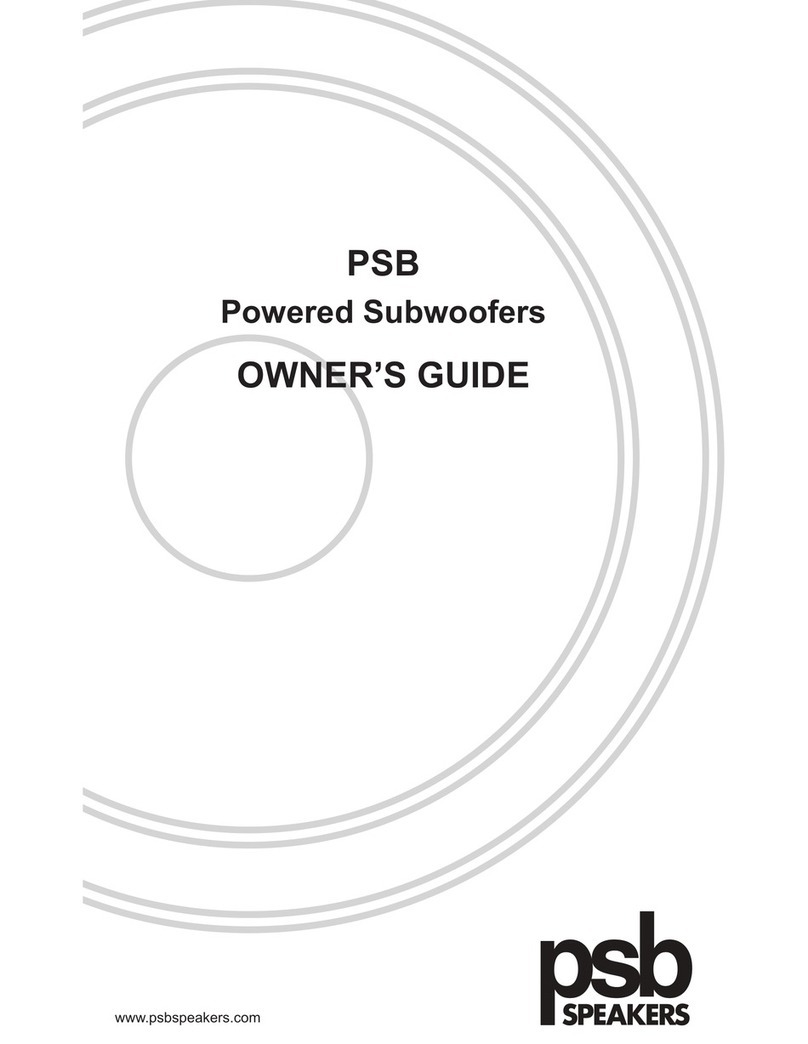
PSB
PSB SubSeries 450 User manual
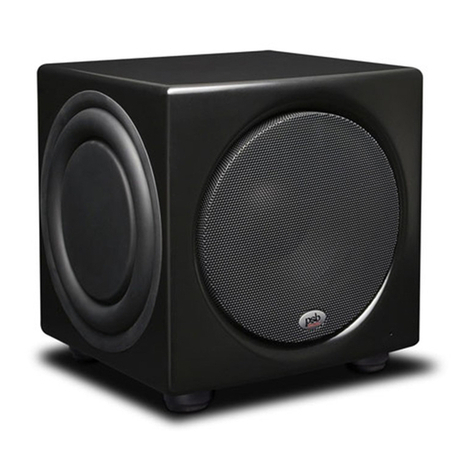
PSB
PSB HD8 User manual

PSB
PSB Sub Series User manual
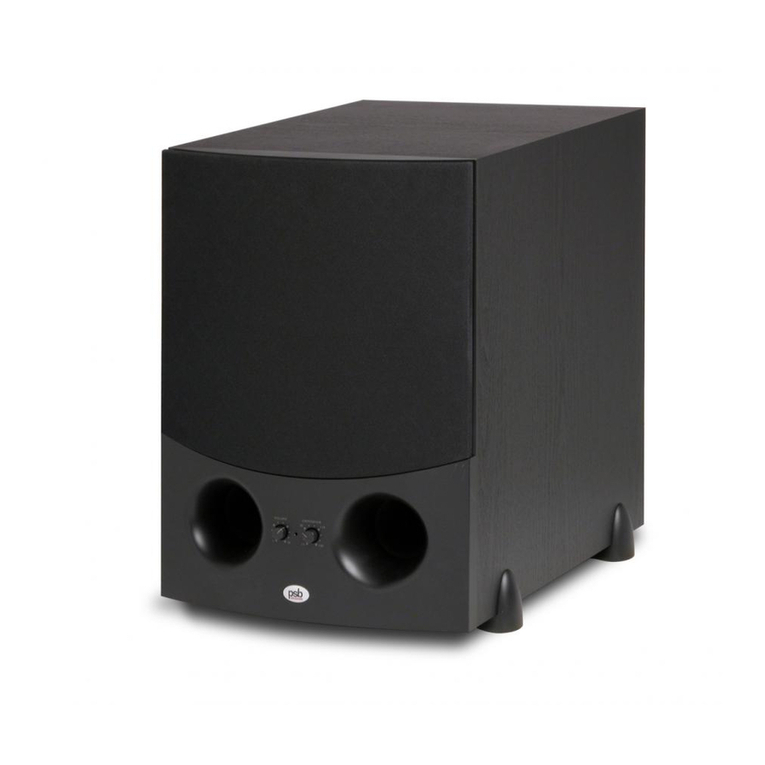
PSB
PSB SubSeries 6i User manual
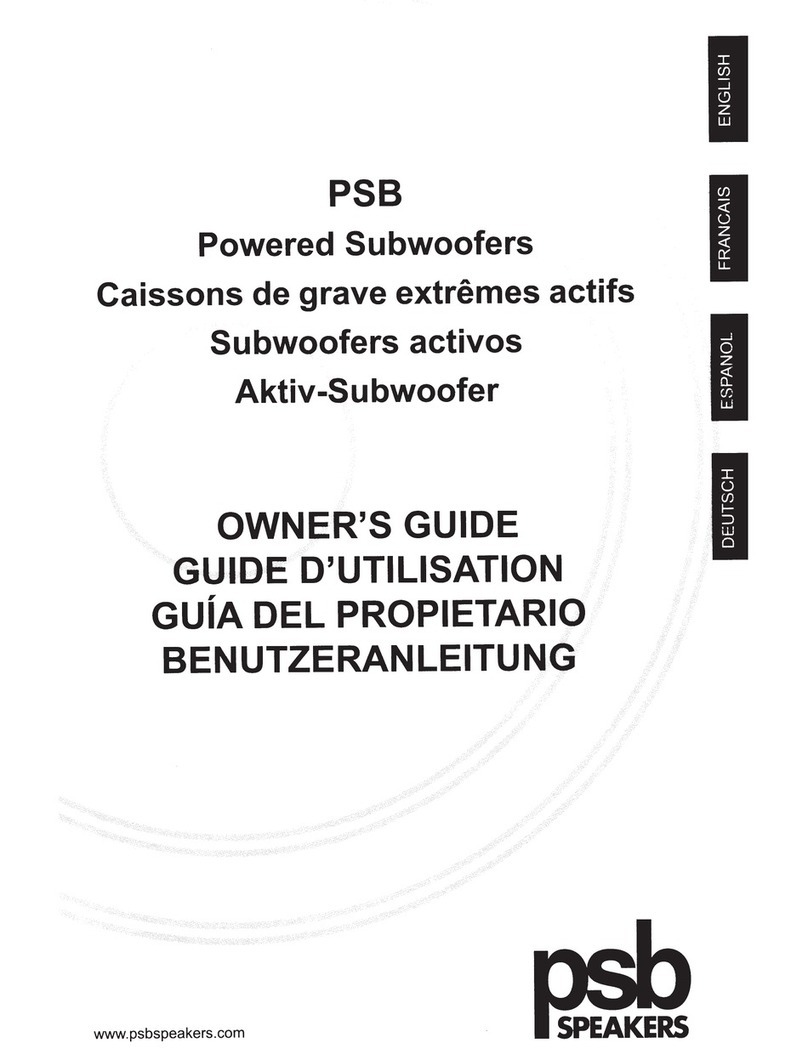
PSB
PSB Powered Subwoofers User manual

PSB
PSB SubSeries 500 User manual
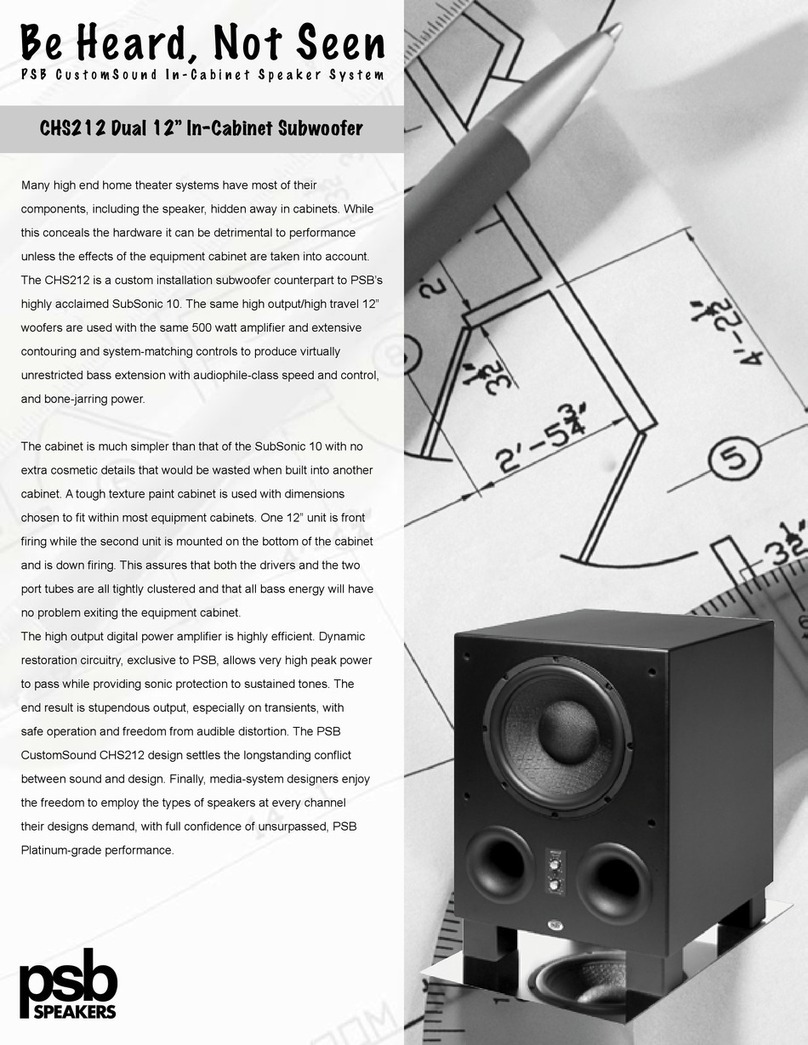
PSB
PSB CHS212 User manual

PSB
PSB SubSeries 500 User manual

PSB
PSB CHS212 User manual

PSB
PSB SubsSonic SubSonic5i User manual
Popular Subwoofer manuals by other brands
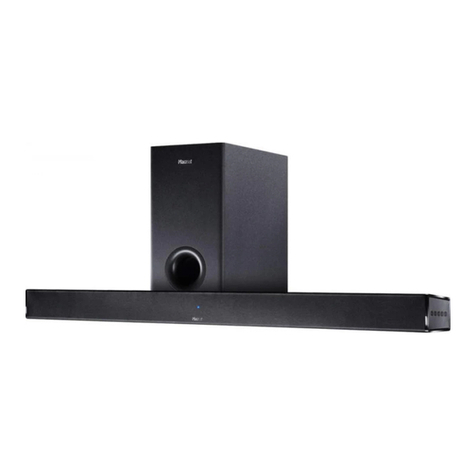
Magnat Audio
Magnat Audio SBW 200 Important notes for installation & warranty card

Hifionics
Hifionics BRUTUS BRZ12D4 user manual
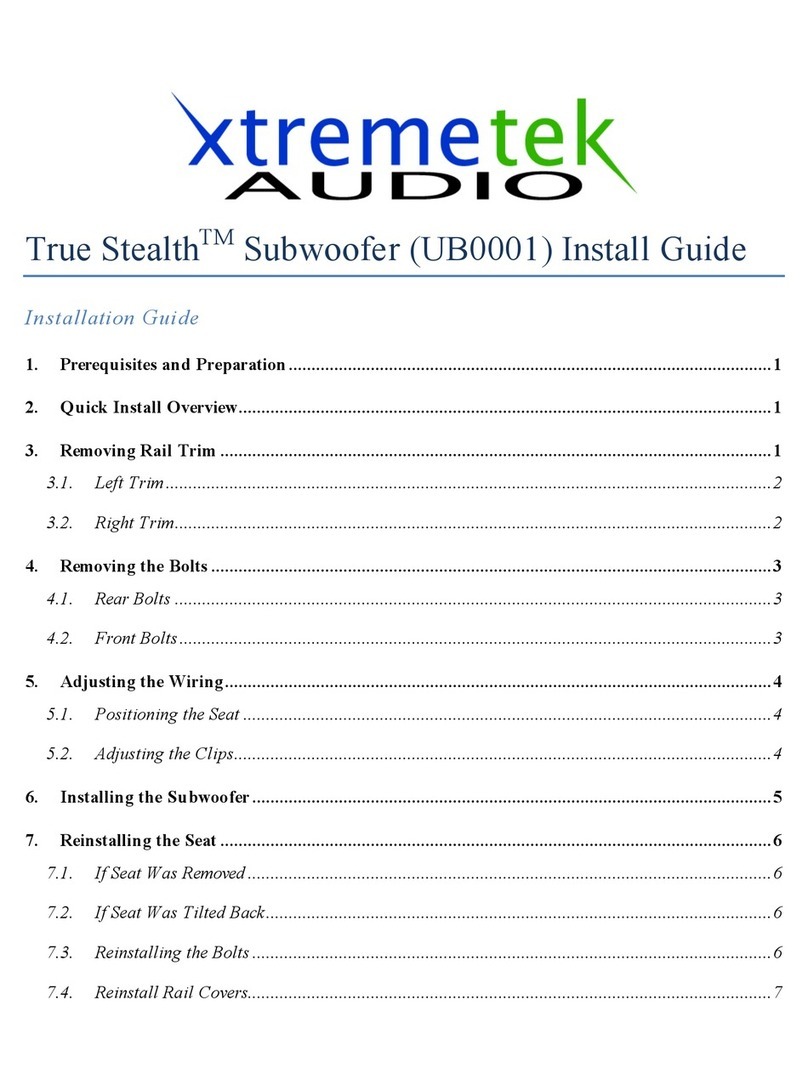
Xtremetek Audio
Xtremetek Audio true stealth ub0001 install guide

Teufel
Teufel US 6112/6 RHD Technical description and operating instructions
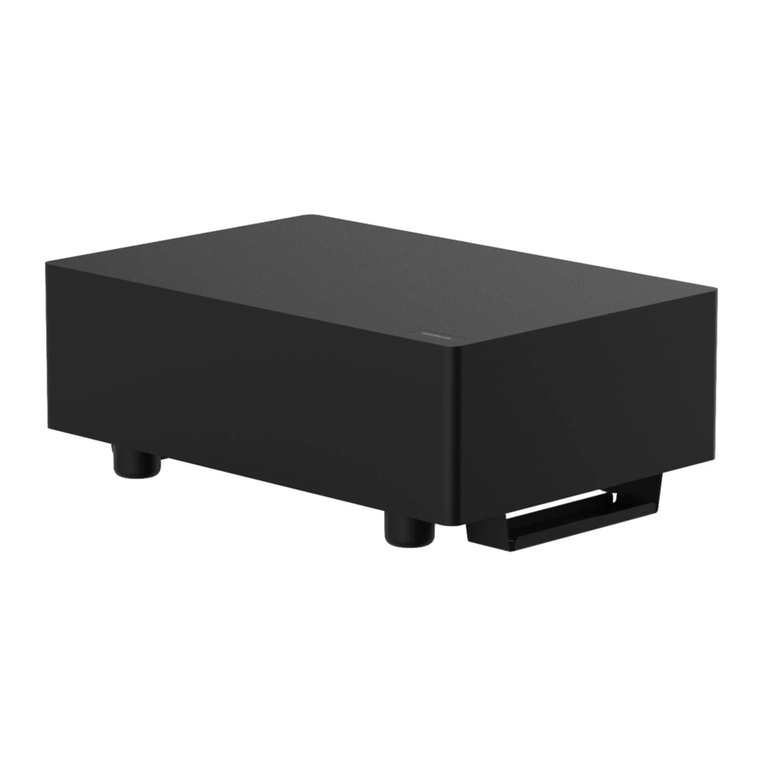
SPOTTUNE
SPOTTUNE SUB user manual

DS18
DS18 JK-SUB12/LR owner's manual
